This article unveils the top 10 best print-on-demand websites for artists. These platforms provide artists with the chance to turn their artwork into a variety of products, spanning from personalized merchandise to home décor, offering both a creative outlet and potential global exposure.
1. Redbubble
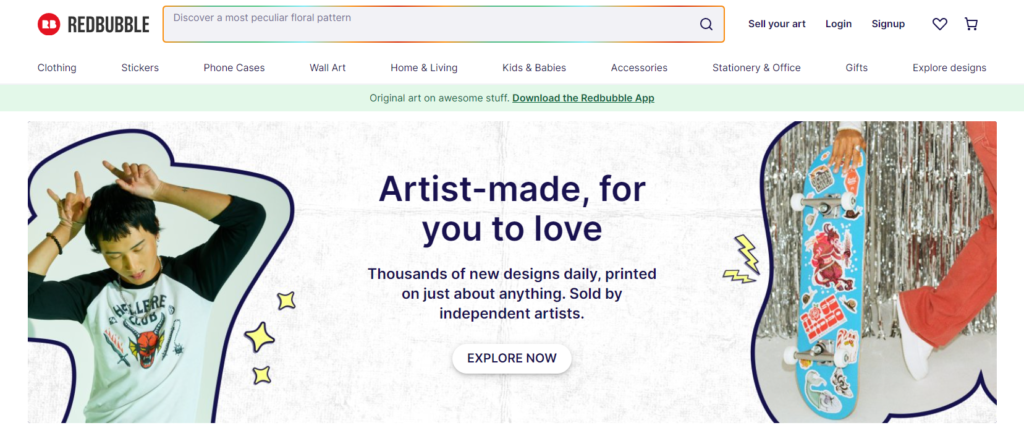
Redbubble is an online marketplace that was founded in Melbourne, Australia in 2006. Currently, it supports 700,000 artists, allowing them to create their own Redbubble store designs using a variety of products and sell their artwork for a profit. Redbubble takes care of the printing, manufacturing, and shipping processes.
Pros
- Redbubble stands out as the most visited print-on-demand platform, offering artists a global stage to showcase and sell their artwork. It draws a diverse audience from across the globe.
- Artists can present their designs on various products, encompassing clothing, stickers, phone cases, wall decorations, and more, giving customers a broad array of choices.
- The platform is designed to be user-friendly, enabling artists to upload and manage their designs without the need for technical expertise.
Cons
- The popularity of Redbubble has led to a substantial influx of artists and designers on the platform, resulting in heightened competition.
- Redbubble handles the manufacturing process, and artists may not have direct oversight or control over it.
Profits
The retail price on Redbubble is determined by combining the base price, artist profit, and sales tax. The artist margin (which includes markup) defaults to 20%.
2. Zazzle

Zazzle serves as an online marketplace with a community of 900,000 artists, permitting designers, artists, and individuals to craft and sell personalized products. Like Redbubble, Zazzle offers a platform where users can upload their designs and have them printed on a range of items, including clothing, accessories, greeting cards, and invitations.
Pros
Zazzle boasts a diverse array of products, spanning apparel, accessories, home décor, stationery, and more. Additionally, the platform collaborates with manufacturers in 130 countries worldwide.
Cons
Zazzle implements a stringent approval process for new designs, a procedure that can prove to be time-consuming for users.
Profits
The standard commission rate on Zazzle is 15% per sale, accompanied by a potential volume bonus of up to 17%.
3. JetPrint
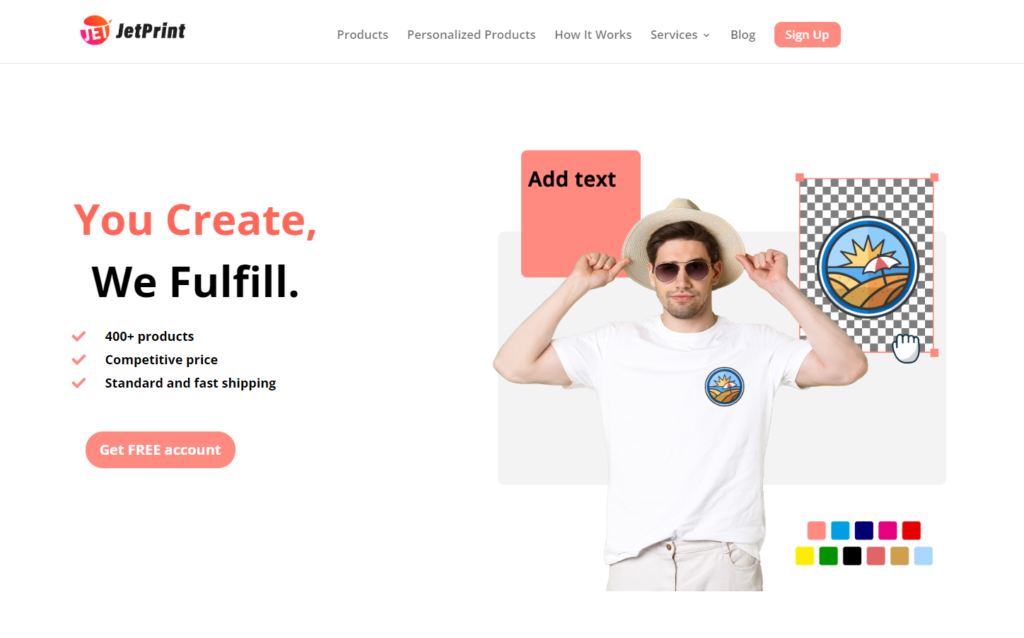
JetPrint is a Chinese company established in 2017, offering artists a multi-platform managed prin on demand solution. With JetPrint, users can integrate their e-commerce stores on platforms such as Shopify, Woocommerce, and Etsy. This enables artists to create and manage their own online stores seamlessly through JetPrint, ensuring uniform order management across multiple platforms.
Pros
- JetPrint offers a range of product categories, featuring shoes, PU leather bags, and AOP (All Over Print) clothing.
- Easy-to-use mockup generator.
- With automated order fulfillment, JetPrint efficiently handles orders, relieving artists of time and energy-consuming tasks.
- Artists using JetPrint have the freedom to set their own prices, directly impacting their profit margins.
Cons
There is a limitation as the platform currently lacks options for greeting cards and gift packaging.
Profits
- Artists can implement custom pricing for their products.
- There are no restrictions on artists’ profits, providing them with full control over their earnings.
4. Teespring
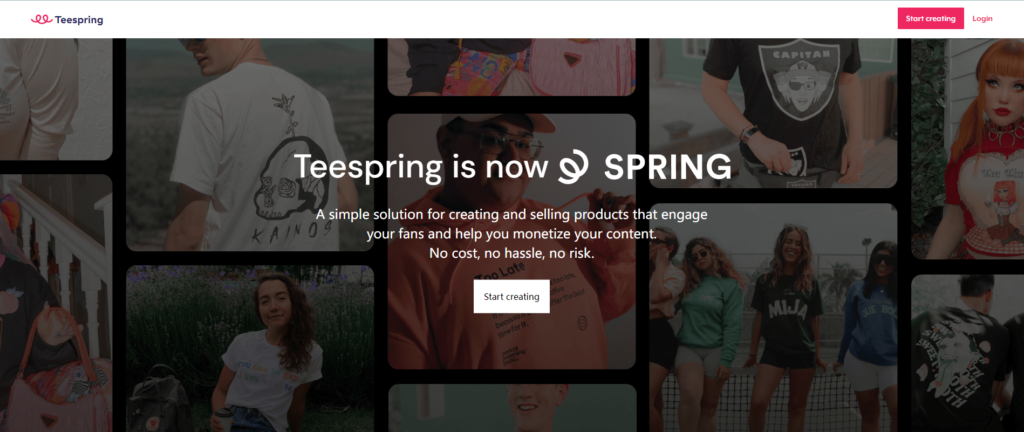
Teespring is a platform that empowers users to design and sell customized clothing online, offering a variety of products such as T-shirts, hoodies, and other apparel. Users have the flexibility to create their own designs, set prices, and promote their products without incurring upfront costs or managing inventory.
Pros
- Teespring seamlessly integrates with popular social media platforms, facilitating easy promotion for users.
- Teespring is accessible to artists on a budget as it does not charge any upfront fees.
Cons
- Not all designs are freely allowed, such as the American flag.
- Teespring specializes in clothing, offering a selection of just over 50 products for users to choose from.
Profits
- Artists can implement custom pricing for their products.
- There are no restrictions on artists’ profits, providing them with full control over their earnings.
5. Society6
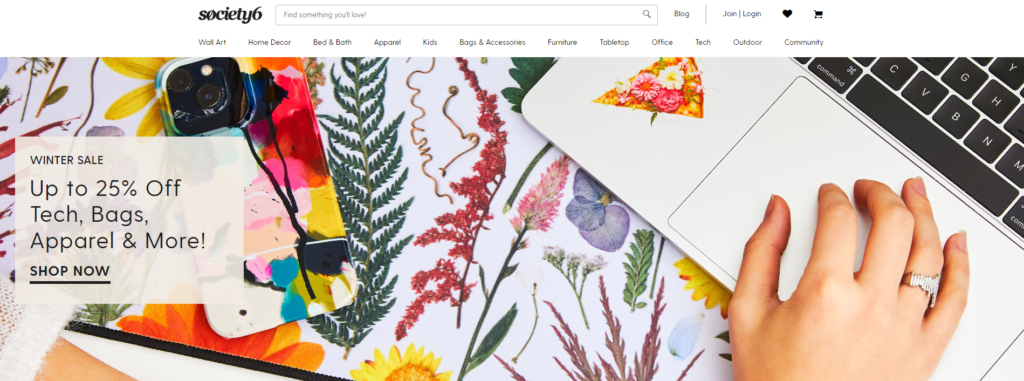
Society6 serves as an online marketplace with a community of 450,000 artists, providing a platform for artists to showcase and sell their art on a diverse range of products. The platform operates on a print-on-demand model, akin to other platforms such as Redbubble and Zazzle.
Pros
- Society6 hosts a curated marketplace, offering exposure to art lovers and collectors.
- The platform places a strong emphasis on quality, ensuring customers receive high-quality products.
Cons
- Society6 establishes the base price, restricting artists’ control over their profit margins.
- In comparison to Redbubble, the platform has a lower level of popularity.
- Society6 offers a selection of just over 90 products for users to choose from.
Profits
Choose the cheapest plan for only 10% profit.
6. Saatchi Art
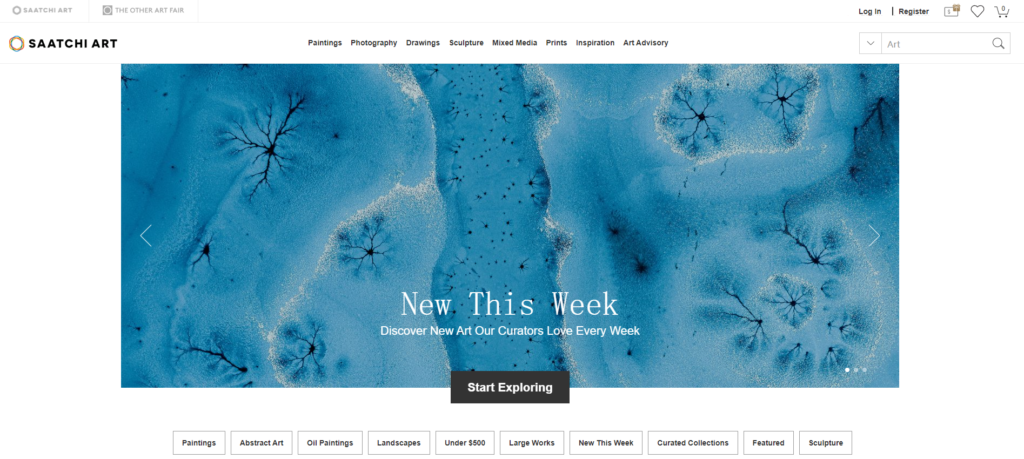
Saatchi Art, founded in 2006, is an online art gallery featuring over 1.4 million paintings, drawings, sculptures, and photographs from more than 90,000 artists. The platform connects artists with art enthusiasts and buyers, providing a direct avenue for artists to showcase and sell their original artwork to a global audience.
Pros
- Saatchi Art is renowned for its dedication to fine art, appealing to discerning art buyers and collectors.
- The platform offers art consulting services and facilitates connections between artists and potential buyers.
- Saatchi Art proves to be highly profitable for artists.
Cons
Not every artist may be accepted onto the platform, as Saatchi Art operates a jury selection process.
Profits
Artists can receive over 40% of the profits for original art on the platform.
7. Spreadshirt
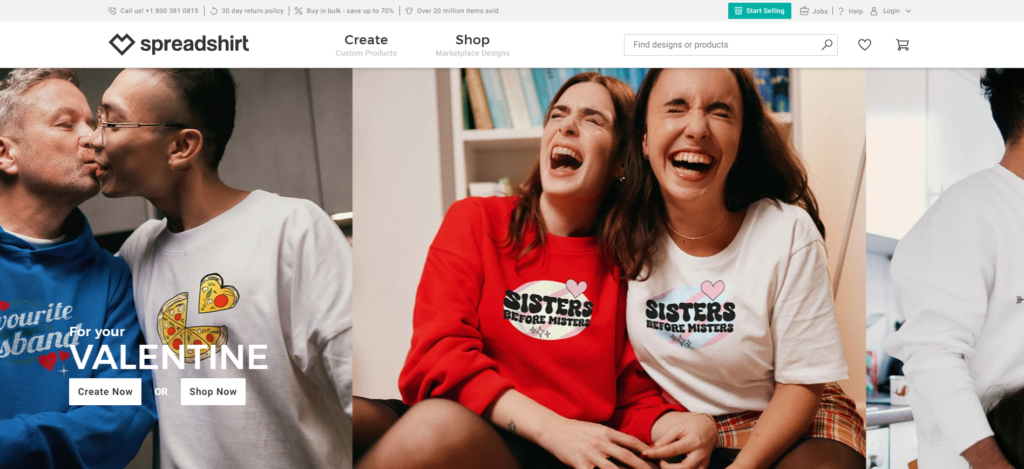
Spreadshirt is an e-commerce company founded in Germany in 2002. The platform empowers users to create personalized T-shirts, hoodies, hats, and various other products through a range of customization options. Artists have the option to display their designs on Spreadshirt’s marketplace or establish an independent store. It’s important to highlight that SPOD, another print-on-demand platform, operates under Spreadshirt. While you can integrate SPOD into your e-commerce website, it’s crucial to note that the products offered by SPOD and Spreadshirt are independent of each other.
Pros
- Artists have the option to provide volume discounts to attract larger orders.
- The platform ensures transparent pricing, aiding artists in making well-informed decisions.
Cons
- There are defects in the print quality of the product.
- While Spreadshirt offers a diverse range of products, it may not rival the variety offered by some of its competitors.
Profits
- When selling on the Spreadshirt market, you have the flexibility to customize the price.
- By signing up for Spreadshop on Spreadshirt, you can earn a 20% sales commission on your sales.
8. Teepublic
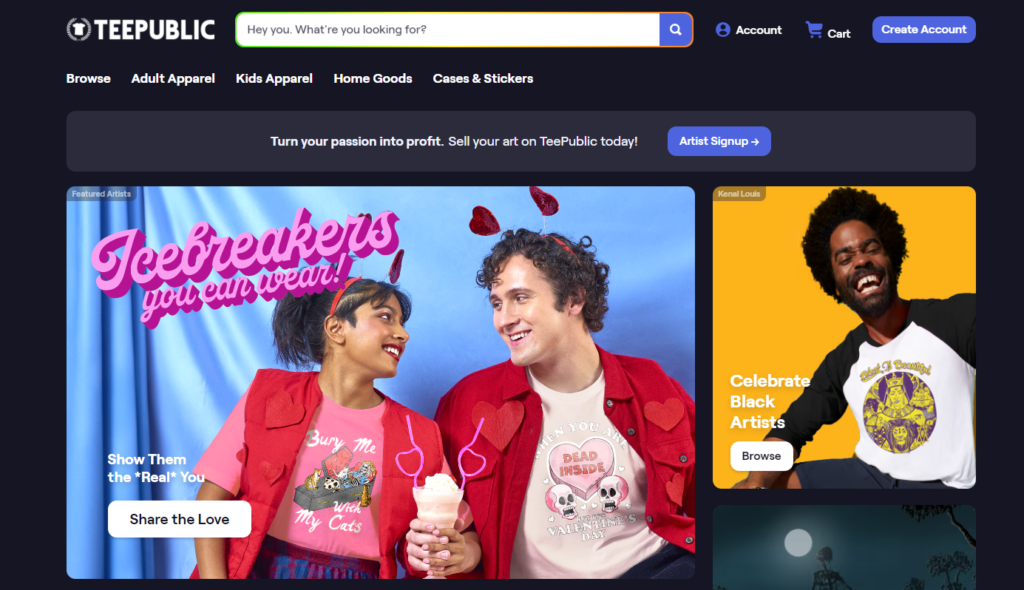
TeePublic stands as a print-on-demand online marketplace, empowering independent artists and designers to craft and sell custom-designed apparel and merchandise. The platform currently offers a diverse range of over 100 products for artists to showcase their designs.
Pros
- Teepublic prioritizes promoting and supporting independent artists, striving to enhance their visibility.
- The platform actively fosters a sense of community among artists, promoting collaboration and mutual support.
Cons
- Commissions on TeePublic are set at a relatively low rate and are determined by the platform.
- It appears that TeePublic may not provide 24/7 support based on the information available.
Profits
TeePublic’s comprehensive compensation structure is as follows: Under normal circumstances, selling a T-shirt can earn you $4, while under promotional circumstances, the earning is $2.
9. Spoonflower

Spoonflower is a company that specializes in custom fabrics, wallpapers, and home décor products. It enables artists to create their own patterns and prints, which can be printed on various types of fabrics, wallpapers, and home decor. Spoonflower also offers shipping services from the United States.
Pros
- Spoonflower specializes in fabric printing and caters to artists interested in textile design.
- The company also provides a marketplace where artists can sell their fabric designs.
Cons
- Customer service is slow to respond.
- Spoonflower’s emphasis on fabric design might narrow its appeal to a broader audience.
Profits
You will earn a 10% royalty based on what the customer pays for anitem, inclusive of any discounts applied, rather thanon the full retail price of the item.
10. Fine Art America
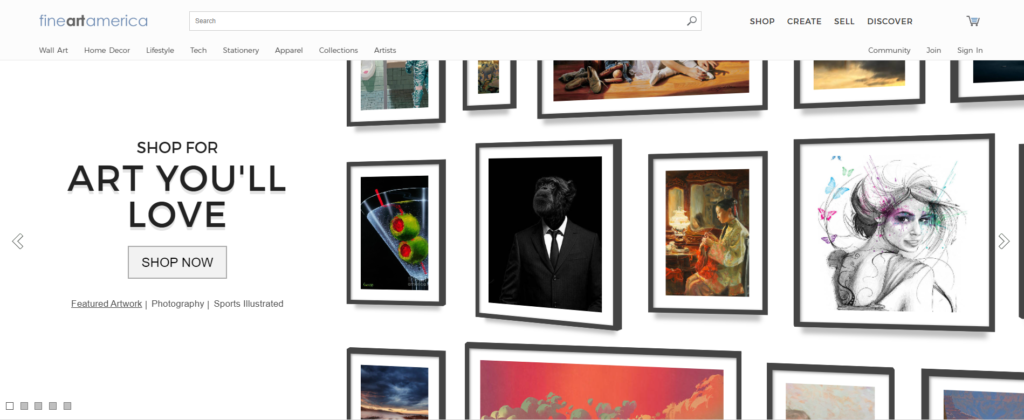
Fine Art America (FAA), established in 2006, is an online platform with 100,000 artists and photographers. Artists have the opportunity to generate designs and utilize Fine Art America to establish their own e-commerce website, selling their creations on the platform’s marketplace. While the platform offers various products, wall art consistently stands out as the best-selling category.
Pros
- Fine Art America operates 16 fulfillment centers worldwide to ensure timely delivery.
- The platform also offers artists a user-friendly interface to effectively manage their portfolios.
Cons
- Uploaded photos have limited file sizes, which limits the quality of the artwork.
- Customization options are limited
Profits
- Artists can implement custom pricing for their products.
- There are no restrictions on artists’ profits, providing them with full control over their earnings.
Final thoughts
Navigating the world of print-on-demand websites demands artists contemplate their goals, preferences, and the distinctive features each platform provides. Whether in search of a global marketplace, customizable options, or a focus on fine art, the top 10 sites mentioned above present artists with a diverse range of opportunities to showcase and monetize their creativity.For those who already possess an e-commerce store, such as Shopify or WooCommerce, or aim to sell items on the Etsy platform, JetPrint stands out as the optimal choice.
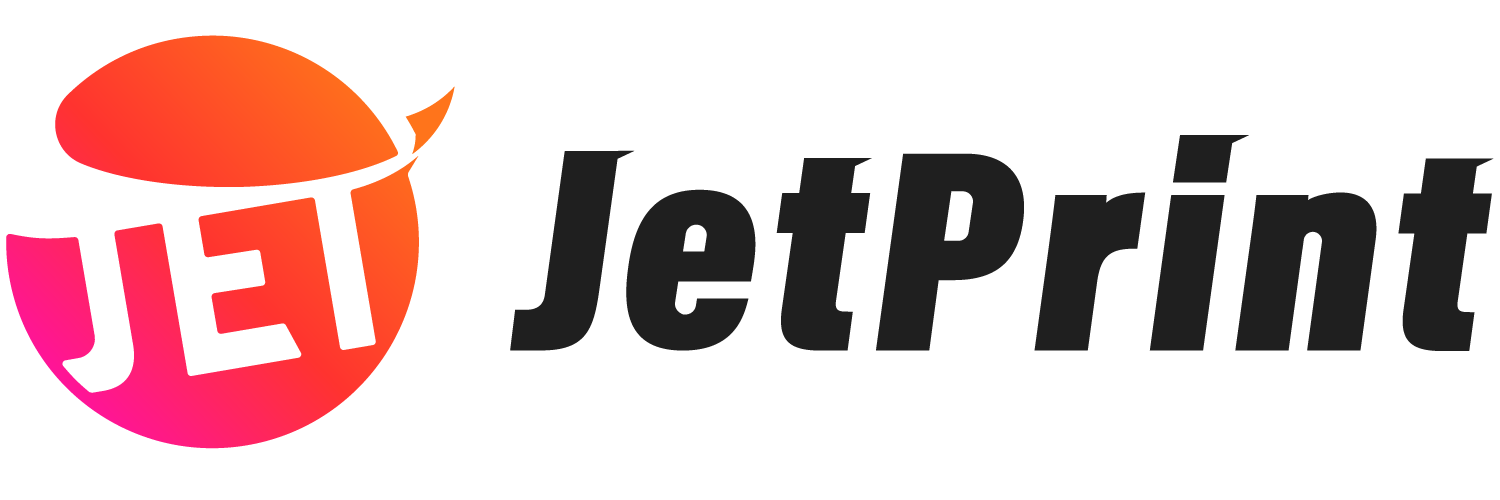

0 Comments